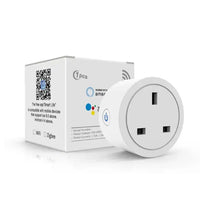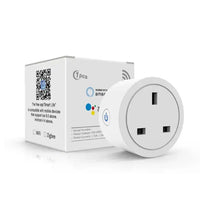Getting Started with your ESPHome / Tasmota smart plug
Share
Getting Started with your ESPHome or Tasmota smart plug
This guide will take you through getting started with your ESPHome or Tasmota based smart plug.
What you'll need
You'll need to have the following handy before you start:
- Your smart plug (either Tasmota or ESPHome). Not got one yet, get one here.
- A laptop or smartphone
- Your Wi-Fi network password
Step 1
Plug in your smart plug, the blue light on the power button should start flashing.

Step 2
2.1 Wi-Fi setup
On your smartphone or laptop navigate to the Wi-Fi connection setting page:

2.2 Connecting to the plug
Select the network that starts with Smart Hut Plug. If you can't see a wifi network starting with smart hut press and hold the the button on the plug for 15 seconds.

2.3 Connecting the plug to your WiFi
You should be presented with a setup web page (Skip to 2.3.1 for Tasmota and 2.3.2 for ESPHome) | Note: if you are not automatically shown the setup page you'll need to open your web browser and navigate to 192.168.4.1
2.3.1 Tasmota
Select Config

Select configure Wi-Fi

and enter your Wi-Fi network details. You can scan for local networks first and then enter your Network name in SSID and your WiFi password

You'll then be disconnected from the temporary Wi-Fi network and the power light on the plug should turn off
2.3.2 ESPHome

Select your Wi-Fi network and enter your Wi-Fi network details. You'll then be disconnected from the temporary Wi-Fi network and the power light on the plug should turn off
Step 3
After a short wait your plug should be connected to your home Wi-Fi network (if not go back to step 2) and you'll be able to connect to it using it's IP address
3.1 Finding your plug's IP address
- Using your router
- Your plug should now appear connected to your router and you can normally find it's IP address by using your routers connected devices page. This is normally accessed by navigating to the IP address 192.168.0.1
- Using an iPhone App
- You can also use an app like Scanny to scan your network. This will list all the connected devices and show you their IP addresses.
- Using an Android App
- You can also use an app like [Add android App] to scan your network. This will list all the connected devices and show you their IP addresses.
You can now control your smart plug via the interact at it's IP address. You can also now configure other software like Home Assistant, OpenHAB or MQTT to connect and use your plug.
3.2 Further setup and integration
- If you have a ESPHome plug this should be automatically detected in Home Assistant, we have another guide here that will take you through setting your plug up in Home Assistant. (And a guide here on getting started with Home Assistant if you're new to home automation)
- If you have a Tasmota plug then you most likely want to set it up using either the Home Assistant Tasmota connection which should auto detect the plug or via MQTT which we have another guide for here.
Troubleshooting
-
I have updated the firmware on my Tasmota plug and now it appears dead / no lights and the button doesn't work
- Tasmota does not retain configuration through firmware updates. You'll need to re-configure the plug.
- Plug in the plug and wait for a wifi network to appear (usually this will start with tasmota- )
- Connect to the tasmota network and re-enter your wifi details
- Re-apply the configuration
- Our template `
{"NAME":"Smart Hut PM","GPIO":[0,0,0,2656,224,2624,320,2720,0,0,0,0,0,0,0,0,0,0,0,0,32,1],"FLAG":0,"BASE":1}` -
Or via the UI 
- Our template `
- Tasmota does not retain configuration through firmware updates. You'll need to re-configure the plug.
-
I have reset the configuration on my Tasmota plug
-
You'll need to re-apply the configuration to the plug
- Re-apply the configuration
- Our template `
{"NAME":"Smart Hut PM","GPIO":[0,0,0,2656,224,2624,320,2720,0,0,0,0,0,0,0,0,0,0,0,0,32,1],"FLAG":0,"BASE":1}` -
Or via the UI
- Our template `
- Re-apply the configuration
-
You'll need to re-apply the configuration to the plug
-
I'd like to re-flash my Tasmota plug with ESPHome or my ESPHome plug with Tasmota
- Unfortunately we are unable to support switching firmware between ESPHome and Tasmota as both firmwares use different internal partition layouts and the plugs are sealed units with no serial access. Attempting to swap between Tasmota and ESPHome will likely result in a non functional plug.
-
Can I use ESPHome without Home Assistant?
- We would advise Tasmota for use with systems other than Home Assistant, ESPHome is designed to work with Home Assistant and will restart every 15 minutes if it is not connected to a Home Assistant instance



